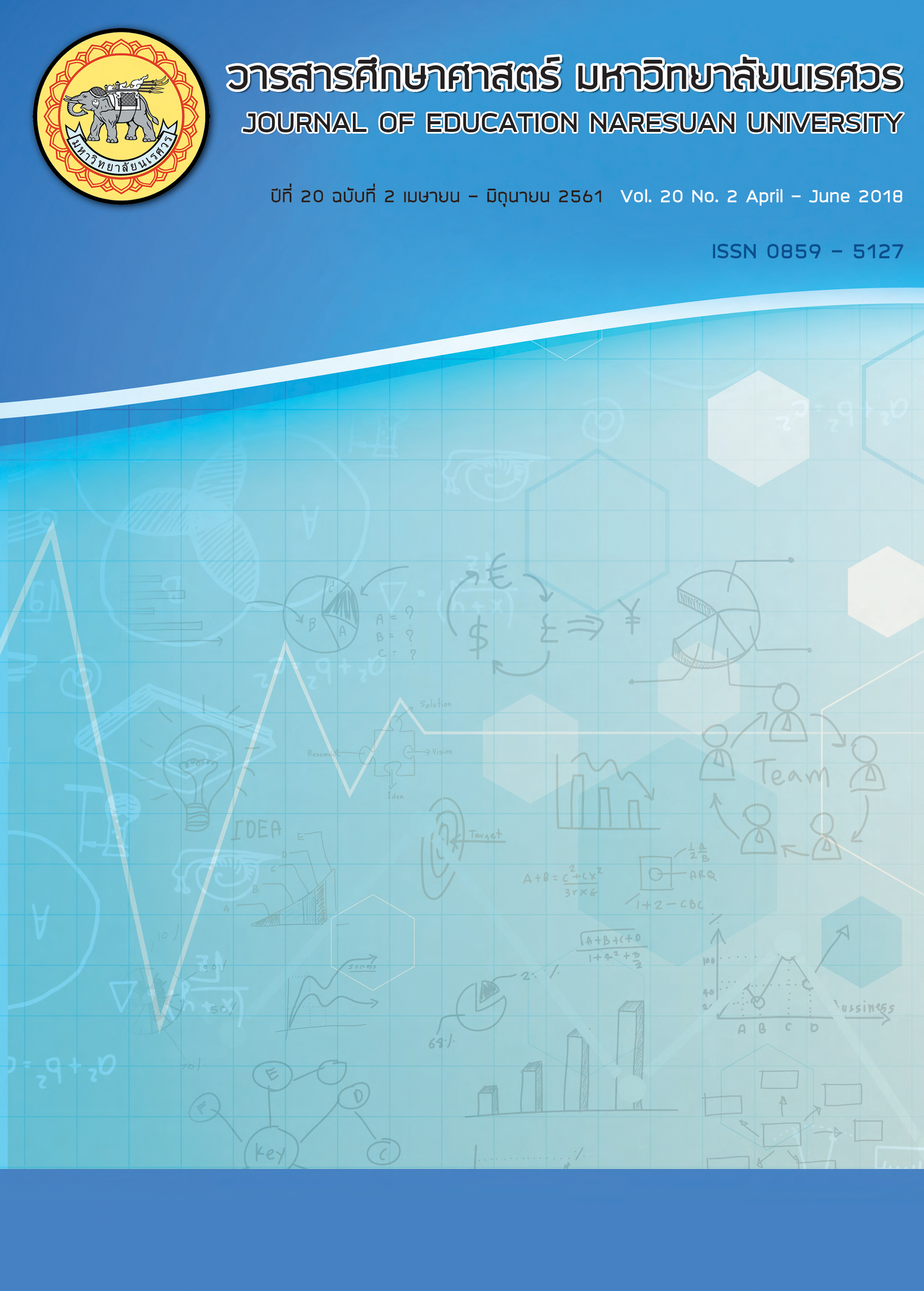การใช้กิจกรรมการสื่อสารเพื่อพัฒนาทักษะการฟัง-พูดภาษาอังกฤษ และความเชื่อมั่นในตนเองของนักเรียนชั้นมัธยมศึกษาปีที่ 3; USING OF COMMUNICATIVE ACTIVITIES TO DEVELOP ENGLISH LISTENING-SPEAKING SKILLS AND SELF-CONFIDENCE OF MATHAYOM SUKSA 3 STUDENTS
Main Article Content
Abstract
การวิจัยครั้งนี้มีวัตถุประสงค์ 1) เพื่อศึกษาทักษะการฟัง-พูดภาษาอังกฤษ ของนักเรียนชั้นมัธยมศึกษาปีที่ 3/2 หลังจากการเรียนโดยใช้กิจกรรมการสื่อสาร 2) เพื่อเปรียบเทียบความเชื่อมั่นในตนเองของนักเรียนชั้นมัธยมศึกษาปีที่ 3/2 ก่อนและหลังจากการเรียนโดยใช้กิจกรรมการสื่อสาร กลุ่มเป้าหมายที่ใช้ในการวิจัยครั้งนี้ เป็นนักเรียนชั้นมัธยมศึกษาปีที่ 3/2 โรงเรียนวมินทราชูทิศ อำเภอเมือง จังหวัดเชียงใหม่ ที่เรียนวิชาภาษาอังกฤษ (อ23102) ในภาคเรียนที่ 2 ปีการศึกษา 2558 จำนวน 39 คน เครื่องมือที่ใช้ในการวิจัยประกอบด้วยแผนการสอนที่ใช้กิจกรรมการสื่อสาร จำนวน 7 แผน แผนละ 3 คาบ คาบละ 50 นาที เครื่องมือที่ใช้ในการเก็บรวบรวมข้อมูล ได้แก่ แบบประเมินทักษะการฟัง-พูดภาษาอังกฤษ และแบบวัดความเชื่อมั่นในตนเอง ผู้วิจัยนำข้อมูลที่ได้มาวิเคราะห์หาค่าเฉลี่ย ส่วนเบี่ยงเบนมาตรฐาน และร้อยละ ผลการวิจัยสรุปได้ ดังนี้
1. ผลการศึกษาทักษะการฟัง-พูดภาษาอังกฤษโดยใช้กิจกรรมการสื่อสาร พบว่า นักเรียนมีทักษะการฟัง-พูดภาษาอังกฤษผ่านเกณฑ์ร้อยละ 60
2. ผลการเปรียบเทียบความเชื่อมั่นในตนเอง พบว่า นักเรียนมีความเชื่อมั่นในตนเองในการฟัง-พูดภาษาอังกฤษสูงขึ้น โดยพัฒนาจากระดับคุณภาพปานกลางเป็นระดับคุณภาพดี
USING OF COMMUNICATIVE ACTIVITIES TO DEVELOP ENGLISH LISTENING-SPEAKING SKILLS AND SELF-CONFIDENCE OF MATHAYOM SUKSA 3 STUDENTS
The purposes of this research were: 1) to investigate the English Listening-Speaking abilities of the target group during being taught using communicative activities, and 2) to compare self-confidence before and after learning being taught by communicative activities. The target group of this research was 39 Mathayomsuksa 3/2 students enrolled in English (E23102) during the second semester of the academic year 2015 at Nawamindarajudis Payap School, Muang, Chiang Mai Province. The research instruments consisted of seven lesson plans and a listening-speaking abilities assessment form and self-confidence evaluation form. The data obtained were analyzed for mean, standard deviation and percentage.
Research findings were as follows:
1. The students’ English listening-speaking abilities passed the pre-set criterion at 60 percent.
2. The students’ self-confidence increased from an average level to a high level.
Article Details
The owner of the article does not copy or violate any of its copyright. If any copyright infringement occurs or prosecution, in any case, the Editorial Board is not involved in all the rights to the owner of the article to be performed.
References
Bowen, J. Donald, Harold Madsen, & Ann Hilferty. (1985). TESOL techniques and procedures. Cambridge, MA: Newbury House Publishers.
Boonchum, W. (2007). Using communicates to promote English listening-speaking abilities and classroom interaction of hill tribe students (Master thesis). Chiang Mai: Chiang Mai University. (in Thai)
Brown, H. D. (1994). Principles of Language Learning and Teaching. San Francisco: Prentice Hall.
Deguang Zhu. (2012). Using games to improve students' communicative ability. Journal of Language Teaching and Research, 3(4), 801-805.
Domesrifa, K. (2008). A study of using oral communicative activities to enhance English speaking ability of Mattayomsuksa one students (Master thesis). Bangkok: Srinakharinwirot University. (in Thai)
Ellis, R. (1994). The study of second language acquisition. Oxford: Oxford University Press.
Jack C. Richards, & Theodore S. Rodgers. (1986). Approaches and methods in language teaching: A description and analysis. Madison: Cambridge University Press.
Kanjunda, K. (2003). Using role play activities based on communicative approach to promote English listening-speaking abilities and motivation of Mathayom Suksa 3 students (Master thesis). Chiang Mai: Chiang Mai University. (in Thai)
Larsen–Freeman, Diane. (2000). Techniques and principles in language teaching. Oxford: Oxford University Press.
Littlewood. (1998). Communicative language teaching (18th ed.). Cambridge: Cambridge. University Press.
Morrow, K. (1981). Principle of communicative and methodology, in communication in the classroom. Applications and methods for communicative approach. London: Longman.
Munby, H. (1982). Analyzing teaching for intellectual independence. Lanham, MD: University Press of America.
Nation, J., & Newton, P. (2009). Teaching ESL/EFL Listening and Speaking. New York: Routledge.
Office of the Basic Education Commission. (2014). Guideline according to Ministry of Education announcement in the policy of teaching English reform. Nonthaburi: The Agricultural Cooperative Federation of Thailand. (in Thai)
Pollard, A., & Tann, S. (1996). Reflective teaching in the primary school (3nd ed.). London: Cassell.
Sriyotha, S. (2012). Problem of studying English at Mathayomsuksa III in extended school under Pattalung primary educational service area 1 (Master thesis). Songkhla: Prince of Songkla University. (in Thai)
Tantrakul, T. (2012). Development of speaking skills for everyday life using conversation exercises (Research report). Bangkok: Sripatum University. (in Thai)
Thanyalak Oradee. (2012). Developing speaking skills using three communicative activities (discussion, problem-solving, and role playing). International Journal of Social Science and Humanity, 2(6), 533-535.
Wang Cheng-Jun. (2006). Designing communicative tasks for college English courses. Retrieved from http:www.asian-efl-journal.com
Wiriyachitra, A. (1989). Communicative language teaching. Bangkok: Aksorn Charoenthat. (in Thai)


